Author:
Joan Hall
Date Of Creation:
27 July 2021
Update Date:
1 July 2024

Content
- Steps
- Part 1 of 4: Home improvement for your rabbit
- Part 2 of 4: Make Your Home Rabbit-Safe
- Part 3 of 4: Feeding your rabbit
- Part 4 of 4: Caring for your rabbit
- Tips
- Warnings
If you want a cute, touching creature to live in your house, get yourself a Dutch dwarf fold rabbit. This breed of rabbit is distinguished by hanging ears and small size, so that the weight of an adult animal can vary from 1300 to 1800 grams. If you learn how to properly care for Dutch Dwarf Fold Rabbits, your healthy and happy pet will delight you and your loved ones.
Steps
Part 1 of 4: Home improvement for your rabbit
 1 Prepare your pet cage. Before you bring the dwarf rabbit home, prepare a cage for it. To select the correct size cage, do the following calculations: The bottom area of the cage is 0.2 square meters for every kilogram of adult rabbit weight. Thus, a Dutch Fold rabbit will need a cage of at least 0.4 square meters. Rabbits of this breed are very active, so make sure there is enough room in the cage for him to run. The width of the cage is taken at the rate of 1.5 times the body length of an adult rabbit, and the length of the cage is the length of the rabbit's body times three. For example, if your rabbit has a body length of 30 centimeters, he will need a cage that is 90 centimeters long and 45 centimeters wide. This space is necessary for the rabbit to run.
1 Prepare your pet cage. Before you bring the dwarf rabbit home, prepare a cage for it. To select the correct size cage, do the following calculations: The bottom area of the cage is 0.2 square meters for every kilogram of adult rabbit weight. Thus, a Dutch Fold rabbit will need a cage of at least 0.4 square meters. Rabbits of this breed are very active, so make sure there is enough room in the cage for him to run. The width of the cage is taken at the rate of 1.5 times the body length of an adult rabbit, and the length of the cage is the length of the rabbit's body times three. For example, if your rabbit has a body length of 30 centimeters, he will need a cage that is 90 centimeters long and 45 centimeters wide. This space is necessary for the rabbit to run. - In addition, you need to consider that part of the cage will be occupied by utensils for water and food, a litter box and a house where your pet can be alone. Therefore, buy a cage at least twice as large as you calculated based on the size of the animal.
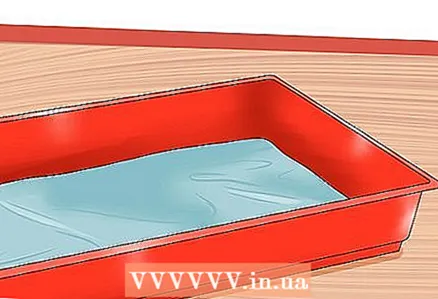 2 Equip the bottom of the cage. The bottom of the rabbit cage needs to be firm, so cover the wire bottom with a suitable material. The wire bottom of the cage can injure the paw pads of the rabbit, and the dwarf animal (including the Dutch Fold rabbit) can accidentally slip its paw between the bars, where it gets stuck, and get injured. Place a carpet or wood flooring on the bottom so that it completely covers the bottom of the cage.
2 Equip the bottom of the cage. The bottom of the rabbit cage needs to be firm, so cover the wire bottom with a suitable material. The wire bottom of the cage can injure the paw pads of the rabbit, and the dwarf animal (including the Dutch Fold rabbit) can accidentally slip its paw between the bars, where it gets stuck, and get injured. Place a carpet or wood flooring on the bottom so that it completely covers the bottom of the cage. - You can put a piece of fleece fabric on the bottom: if the rabbit eats part of this covering, this will not damage his digestive system, since the fibers of the fleece fabric are quite short.
- You can also put newspapers underneath the cage, just don't use them as bedding.
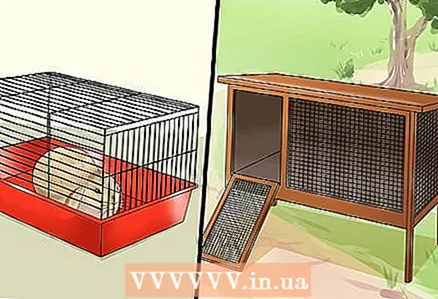 3 Think about where the cage will be - outside or inside. Both solutions have their advantages. The rabbits living in the house have a longer life span, they are more cheerful and willingly communicate with people. Their fluffy cousins living in the fresh air are more fearful and susceptible to such negative factors as temperature changes, weather changes, predators, fleas, ticks, flies and other adverse factors.
3 Think about where the cage will be - outside or inside. Both solutions have their advantages. The rabbits living in the house have a longer life span, they are more cheerful and willingly communicate with people. Their fluffy cousins living in the fresh air are more fearful and susceptible to such negative factors as temperature changes, weather changes, predators, fleas, ticks, flies and other adverse factors. - If you decide that you will keep your rabbit in the house, but you do not have enough free space, equip your pet with an outdoor aviary where he can run and play freely.
- If you keep your rabbit in a cage outdoors, there will be plenty of room for him to run and play. In addition, such a cage is much easier to clean. Choose a place for the cage that is protected from direct sunlight, drafts, flooding, excessive humidity, too high and too low temperatures, and loud noises. Your rabbit's home needs a roof to keep it out of the rain, and make sure your rabbit is not threatened by predators, including dogs and cats.
 4 Take care of the bedding. In the cage, there must be a bedding on which the rabbit will sleep. Make sure the material is edible for the rabbit, as your pet will likely eat its own bedding. For these purposes, meadow grass and timothy hay, natural fiber fabric, granular paper filler and other natural materials are quite suitable.
4 Take care of the bedding. In the cage, there must be a bedding on which the rabbit will sleep. Make sure the material is edible for the rabbit, as your pet will likely eat its own bedding. For these purposes, meadow grass and timothy hay, natural fiber fabric, granular paper filler and other natural materials are quite suitable. - Make sure you put enough litter material in the cage so the rabbit can burrow into it and move the litter to his liking.
- Check the condition of the litter daily and replace it with a new one if necessary. The bunny should not use the litter bed as a litter box, so if it does, your bunny is running out of space. In this case, you should expand the cage or aviary so that the rabbit can run freely, play and actively move. If the litter is not changed in time, it will turn into a breeding ground for fleas, flies and other harmful insects.
- Materials such as straw, cardboard, newsprint, wood shavings and sawdust, cat litter, and cedar or pine products should not be used for bedding. All of these foods are bad for your pet's health.
 5 Place a litter box in the cage. Place a box in the cage that the rabbit can use as a toilet. For a dwarf fold rabbit, a small cat litter box will suffice. Keep in mind that it's best to get a slightly larger litter box, which is guaranteed not to be too small for your pet. Fill the tray with fresh hay. If desired, place rabbit-safe toilet litter at the bottom of the litter box and top with hay.
5 Place a litter box in the cage. Place a box in the cage that the rabbit can use as a toilet. For a dwarf fold rabbit, a small cat litter box will suffice. Keep in mind that it's best to get a slightly larger litter box, which is guaranteed not to be too small for your pet. Fill the tray with fresh hay. If desired, place rabbit-safe toilet litter at the bottom of the litter box and top with hay. - Organize a food space and toilet at opposite ends of the cage. The toilet space should be where the rabbit defecates, and the fresh hay that the rabbit will eat should be placed on the opposite end of the cage.
- If you are keeping multiple rabbits in the same cage, place a large litter box or multiple litter boxes, one for each animal.
- Change the litter in the tray regularly. The rabbit will not use the tray if it is dirty. Try to empty the tray daily. Simply remove the litter box from the cage, discard the contents in the trash can, wash it, and add fresh rabbit-safe litter.
- Don't let your rabbit out of the cage until he learns how to use the litter box.
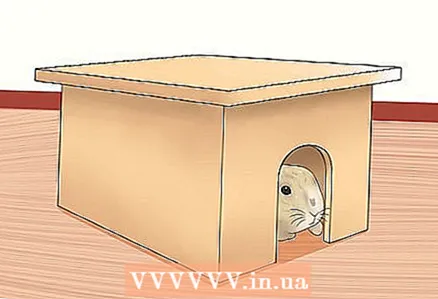 6 Make a place for your rabbit to hide. Rabbits are very careful by nature, so they hide from predators, loud noises and other frightening factors. You need to build a shelter for your pet, such as a cardboard box, a tunnel system made of wide cardboard tubes, or some other enclosed space where your rabbit can easily hide. If you like, you can buy special rabbit huts at the pet store.
6 Make a place for your rabbit to hide. Rabbits are very careful by nature, so they hide from predators, loud noises and other frightening factors. You need to build a shelter for your pet, such as a cardboard box, a tunnel system made of wide cardboard tubes, or some other enclosed space where your rabbit can easily hide. If you like, you can buy special rabbit huts at the pet store.
Part 2 of 4: Make Your Home Rabbit-Safe
 1 Try to give your rabbit a separate room in the house. If you decide that the rabbit will live in the house, try to allocate one room where the rabbit can run freely. Take out a portion of the room and place a litter box, a hay feeder, bowls for pellets and herbs, and a saucer of water there. Lay down a waterproof mat to protect the floor from dirt. It can also be installed in a room withbutmugs made of cardboard, special enclosures for rabbits (enclosures for puppies are also suitable) or cages for rabbits.
1 Try to give your rabbit a separate room in the house. If you decide that the rabbit will live in the house, try to allocate one room where the rabbit can run freely. Take out a portion of the room and place a litter box, a hay feeder, bowls for pellets and herbs, and a saucer of water there. Lay down a waterproof mat to protect the floor from dirt. It can also be installed in a room withbutmugs made of cardboard, special enclosures for rabbits (enclosures for puppies are also suitable) or cages for rabbits.  2 Remove or carefully cover electrical wires. Rabbits chew on everything. If you decide that the rabbit will run freely around the room, you need to take care to protect the pet and hide or remove all electrical wires. Buy special plastic tubes that open longitudinally into two halves, put an electric wire inside, after which the tube is again connected into a single whole. You can also hide the cords behind wooden panels or other finishing materials, protect them with a spiral winding, or hide them in a special plastic box.
2 Remove or carefully cover electrical wires. Rabbits chew on everything. If you decide that the rabbit will run freely around the room, you need to take care to protect the pet and hide or remove all electrical wires. Buy special plastic tubes that open longitudinally into two halves, put an electric wire inside, after which the tube is again connected into a single whole. You can also hide the cords behind wooden panels or other finishing materials, protect them with a spiral winding, or hide them in a special plastic box. 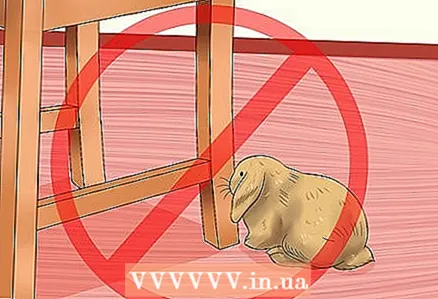 3 Protect furniture and furnishings from your pet's teeth. Rabbits happily gnaw the corners of doors, wall panels and furniture legs. Wallpaper, drywall and even carpeting can also be damaged from the teeth of a small pet.Use planks to protect any items your pet might taste. Place 50x100mm cardboard or boards under the furniture so that the rabbit cannot gnaw a hole in the soft bottom. Cover the walls with clear plastic panels to protect them.
3 Protect furniture and furnishings from your pet's teeth. Rabbits happily gnaw the corners of doors, wall panels and furniture legs. Wallpaper, drywall and even carpeting can also be damaged from the teeth of a small pet.Use planks to protect any items your pet might taste. Place 50x100mm cardboard or boards under the furniture so that the rabbit cannot gnaw a hole in the soft bottom. Cover the walls with clear plastic panels to protect them. - Always keep an eye on your rabbit when you let him run around the room. If your pet is trying to chew on furniture or furnishings, offer them more suitable objects for grinding their teeth.
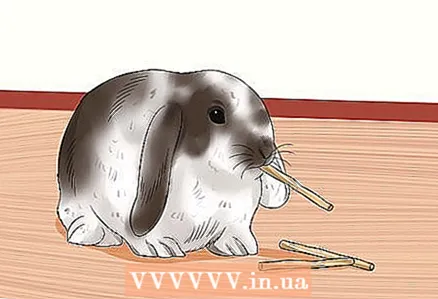 4 Make sure your rabbit always has something to chew on. So that the rabbit does not try to chew on objects that are not suitable for this, make sure that there are enough objects around him that he can sharpen his teeth. Special pressed alfalfa pellets are perfect for this purpose; hay packed tightly in cardboard tubes; freshly cut twigs (apple, willow, or aspen), and even a rolled cotton towel.
4 Make sure your rabbit always has something to chew on. So that the rabbit does not try to chew on objects that are not suitable for this, make sure that there are enough objects around him that he can sharpen his teeth. Special pressed alfalfa pellets are perfect for this purpose; hay packed tightly in cardboard tubes; freshly cut twigs (apple, willow, or aspen), and even a rolled cotton towel.
Part 3 of 4: Feeding your rabbit
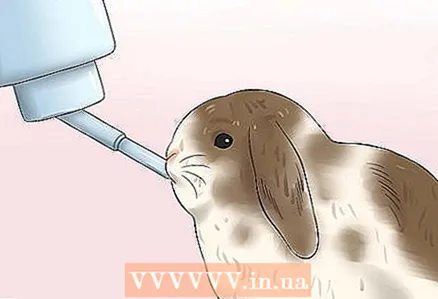 1 Place shallow bowls of water in the cage. You can make a plastic bottle drinker for your pet, or place a ceramic water saucer in the cage. It will be easier for you to keep the drinker clean, but rabbits still prefer to drink water from ceramic dishes.
1 Place shallow bowls of water in the cage. You can make a plastic bottle drinker for your pet, or place a ceramic water saucer in the cage. It will be easier for you to keep the drinker clean, but rabbits still prefer to drink water from ceramic dishes. - If you allow your rabbit to run freely around the room, make sure that the pet can easily find drinking water.
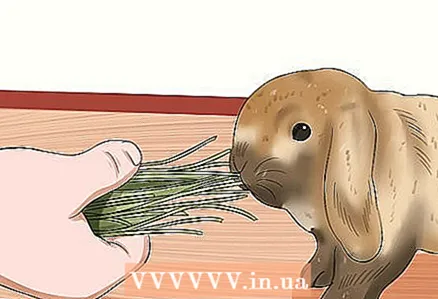 2 Feed your rabbit hay. For the digestive system to function properly, rabbits need to get plenty of fiber and adequate amounts of water. If these conditions are not met, the rabbit can get sick and even die. High quality grass hay is one of the main components of the fold rabbit's diet. Your pet should have unlimited access to hay so he can eat as much as he needs. Remember to regularly remove wet or spoiled hay from the cage and replace it with fresh hay daily.
2 Feed your rabbit hay. For the digestive system to function properly, rabbits need to get plenty of fiber and adequate amounts of water. If these conditions are not met, the rabbit can get sick and even die. High quality grass hay is one of the main components of the fold rabbit's diet. Your pet should have unlimited access to hay so he can eat as much as he needs. Remember to regularly remove wet or spoiled hay from the cage and replace it with fresh hay daily. - Meadow grass hay is best for feeding your pet. It is not recommended to feed rabbits with alfalfa hay - it contains too much protein and calcium, so this hay can only occasionally be given to a fluffy pet as a treat.
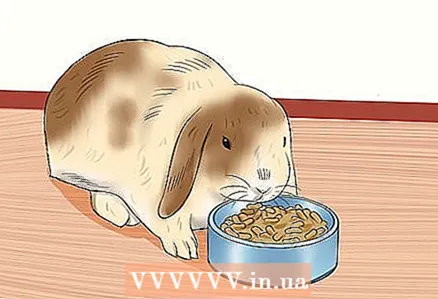 3 Feed your rabbit pellets. Another essential component of the rabbit's diet is ready-made pellets, which are sold in pet stores. Rabbit special pellets are preferable to a mixture of seeds and grains. The composition of the pelleted feed is designed to meet the nutritional needs of the animal. If you give your rabbit a mixture of whole seeds and grains, the fluffy gourmet will only eat the ingredients it loves, and the rest will go uneaten. Such selective nutrition does not contribute to a balanced diet for the rabbit.
3 Feed your rabbit pellets. Another essential component of the rabbit's diet is ready-made pellets, which are sold in pet stores. Rabbit special pellets are preferable to a mixture of seeds and grains. The composition of the pelleted feed is designed to meet the nutritional needs of the animal. If you give your rabbit a mixture of whole seeds and grains, the fluffy gourmet will only eat the ingredients it loves, and the rest will go uneaten. Such selective nutrition does not contribute to a balanced diet for the rabbit. - An adult lop-eared dwarf rabbit eats 10-20 grams of pelleted feed daily.
- Remove uneaten pellets from the cage daily and replace with fresh pellets.
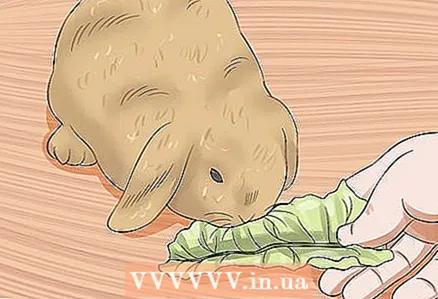 4 Feed your rabbit green food. Green leafy vegetables will help provide your rabbit with the fiber and fluid it needs. Your pet will love all types of lettuce (with the exception of Iceberg lettuce, which is low in nutrients.) Alternatively, feed your rabbit bok choy, broccoli stems and leaves, carrot tops, and dandelion greens. It is enough for your pet to eat 20-40 grams of green food daily.
4 Feed your rabbit green food. Green leafy vegetables will help provide your rabbit with the fiber and fluid it needs. Your pet will love all types of lettuce (with the exception of Iceberg lettuce, which is low in nutrients.) Alternatively, feed your rabbit bok choy, broccoli stems and leaves, carrot tops, and dandelion greens. It is enough for your pet to eat 20-40 grams of green food daily. 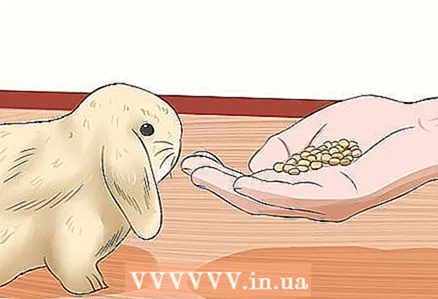 5 Treat your pet to a healthy treat. Rabbits love starchy vegetables like carrots and fresh fruits, but they can only eat more than 50 grams per day. Never feed your rabbit food from your table, or allow your pet to eat corn or other grains. The rabbit's diet should consist mainly of hay, pellets and leafy greens.
5 Treat your pet to a healthy treat. Rabbits love starchy vegetables like carrots and fresh fruits, but they can only eat more than 50 grams per day. Never feed your rabbit food from your table, or allow your pet to eat corn or other grains. The rabbit's diet should consist mainly of hay, pellets and leafy greens.
Part 4 of 4: Caring for your rabbit
 1 Show your rabbit to the vet. Dutch Fold rabbits are distinguished by excellent health, to maintain which it is usually enough to feed them the right, balanced food. However, take your pet to a veterinarian once a year to check the condition of the pet and confirm that your pet is healthy. During the examination, the technician will examine the rabbit's teeth to make sure they are properly worn down. If the veterinarian finds abnormalities, he will carry out the necessary procedures to reduce the size of the teeth. Failure to do this can cause the rabbit to cut its mouth or damage its teeth.
1 Show your rabbit to the vet. Dutch Fold rabbits are distinguished by excellent health, to maintain which it is usually enough to feed them the right, balanced food. However, take your pet to a veterinarian once a year to check the condition of the pet and confirm that your pet is healthy. During the examination, the technician will examine the rabbit's teeth to make sure they are properly worn down. If the veterinarian finds abnormalities, he will carry out the necessary procedures to reduce the size of the teeth. Failure to do this can cause the rabbit to cut its mouth or damage its teeth.  2 Sterilize your rabbit. Rabbits of both sexes should be spayed at four to six months of age. This will help avoid unplanned breeding of rabbits if you have a male and female in your house. In addition, sterilization helps to cope with undesirable behavior of the animal: the rabbit will become less aggressive and stop marking the territory by irrigating it with urine. It is important to mention that sterilization helps to avoid infections and malignant neoplasms of the reproductive system.
2 Sterilize your rabbit. Rabbits of both sexes should be spayed at four to six months of age. This will help avoid unplanned breeding of rabbits if you have a male and female in your house. In addition, sterilization helps to cope with undesirable behavior of the animal: the rabbit will become less aggressive and stop marking the territory by irrigating it with urine. It is important to mention that sterilization helps to avoid infections and malignant neoplasms of the reproductive system. 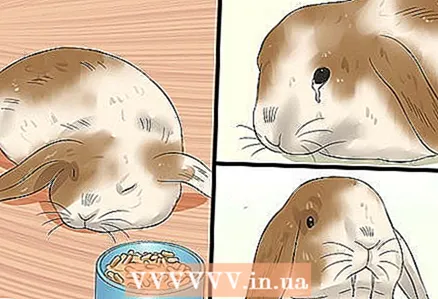 3 Watch for signs of illness. In most cases, eating well will help your rabbit stay healthy. However, always look for signs that indicate your pet is sick. Some symptoms that should alert you: refusing food and water, diarrhea, stool for 24 hours, discharge from the nose and eyes, drooling, swelling or swelling, skin redness, hair loss all over the body, dark or reddish urine, and increased body temperature above 40 ° C. In some cases, the animal's coordination of movements is impaired, it cannot jump or walk as usual, or is unable to use its hind legs.
3 Watch for signs of illness. In most cases, eating well will help your rabbit stay healthy. However, always look for signs that indicate your pet is sick. Some symptoms that should alert you: refusing food and water, diarrhea, stool for 24 hours, discharge from the nose and eyes, drooling, swelling or swelling, skin redness, hair loss all over the body, dark or reddish urine, and increased body temperature above 40 ° C. In some cases, the animal's coordination of movements is impaired, it cannot jump or walk as usual, or is unable to use its hind legs. - Never ignore these symptoms. If you notice any of the above signs, immediately take the animal to the veterinarian for examination.
Tips
- You can make toys from scrap materials that your pet will surely like, for example: a small box of thick cardboard filled with hay; toilet paper rolls; toilet paper or wrapping paper left over from gifts. You can also arrange the cardboard boxes to create a bunny tunnel.
- If you take a large paper bag, fill it with cut strips of newsprint and hide two or three pieces of bunny treats in the paper, your pet will be happy to rummage through the paper ribbons to find a treat.
Warnings
- If you take the rabbit in your arms incorrectly, it hits hard with its hind legs, which can lead to spinal injuries in the pet. When you lift the rabbit, bring one hand under the back of the animal, and with the other hand support it at the level of the chest.
- You may notice that rabbits have a softer consistency at night than in daytime. This is completely normal, as well as the fact that the animal immediately eats such stool, as it is necessary for the proper functioning of the digestive system. If you notice soft feces in the cage, do not confuse it with diarrhea. On the contrary, it is an indicator of your pet's healthy digestion.
- If you decide to introduce a new food, leafy greens, vegetables or fruits into the rabbit's diet, do not rush to give the animal a lot of new food. To get started, try feeding your pet a few small bites throughout the day and see if your rabbit has a digestive upset.



